15 of the Most Beautiful Crater Lakes in the World
A crater lake is a lake that forms in a volcanic crater or caldera, such as a maar; less commonly and with lower association to the term a lake may form in an impact crater caused by a meteorite, or in an artificial explosion caused by humans.
Sometimes lakes which form inside calderas are called caldera lakes, but often this distinction is not made. Crater lakes covering active (fumarolic) volcanic vents are sometimes known as volcanic lakes, and the water within them is often acidic, saturated with volcanic gases, and cloudy with a strong greenish color. Lakes located in dormant or extinct volcanoes tend to have fresh water, and the water clarity in such lakes can be exceptional due to the lack of inflowing streams and sediment.
Crater lakes form as precipitation within the rim fills the created depression. The water level rises until an equilibrium is reached between the rate of incoming and outgoing water. Sources of water loss singly or together, may include evaporation, subsurface seepage, and in places, surface leakage or overflow when the lake level reaches the lowest point on its rim.
1. Crater Lake, Mount Mazama – Oregon, USA

A well-known crater lake, which bears the same name as the geological feature, is
Crater Lake in Oregon, USA. It is located in the caldera of Mount Mazama. It is the
deepest lake in the United States with a depth of 1,949 ft. Crater Lake is fed
solely by falling rain and snow, with no inflow or outflow at the surface, and hence
is one of the clearest lakes in the world.
2. Quilotoa Crater Lake – Ecuador

Quilotoa is a water-filled caldera and the most western volcano in the Ecuadorian Andes.
The 2 mile wide caldera was formed by the collapse of this dacite volcano following a
catastrophic VEI-6 eruption about 800 years ago, which produced pyroclastic flows and
lahars that reached the Pacific Ocean, and spread an airborne deposit of volcanic ash
throughout the northern Andes. The caldera has since accumulated a 820 ft deep crater
lake, which has a greenish color as a result of dissolved minerals. Fumaroles are found
on the lake floor and hot springs occur on the eastern flank of the volcano.
3. Crater Lakes in the Albertine Rift – Africa

In a region bursting with people, a few big open spaces remain—like the Rift floor in Queen Elizabeth Park, pocked with crater lakes formed by volcanic explosions. If protected areas hadn’t been set aside in the Albertine Rift from the 1920s to the 1960s, conservationists doubt any large wilderness areas would exist today.
4. Kelimutu Crater Lake – Flores Island, Indonesia
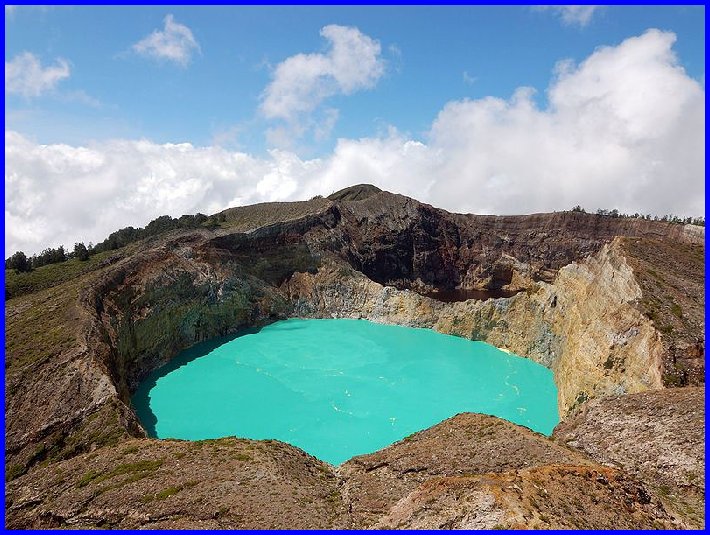
Kelimutu volcano contains three striking summit crater lakes of varying colors. Tiwu Ata Mbupu (Lake of Old People) is usually blue and is the westernmost of the three lakes. The other two lakes, Tiwu Nuwa Muri Koo Fai (Lake of Young Men and Maidens) and Tiwu Ata Polo (Bewitched or Enchanted Lake) are separated by a shared crater wall and are typically green or red respectively. Kelimutu is of interest to geologists because the three lakes are different colors yet are at the crest of the same volcano.
5. Crater Lake, Mount Pinabuto – Luzon, Philippines
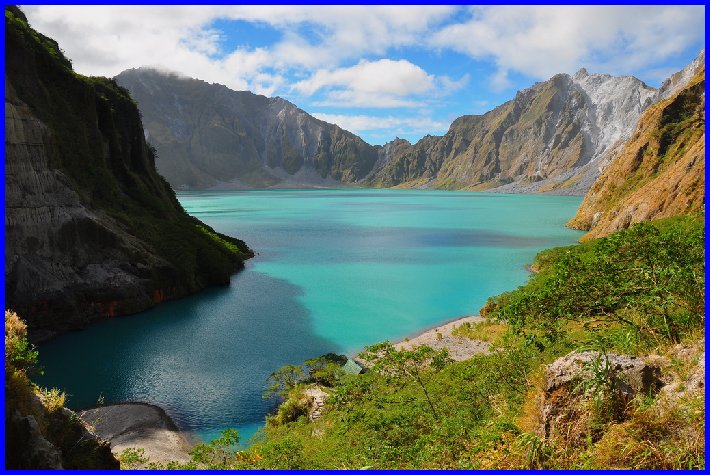
Lake Pinatubo is the summit crater lake of Mount Pinatubo formed after its climactic eruption on June 15, 1991. The lake is located near the boundaries of Pampanga, Tarlac and Zambales provinces in the Philippines and is the deepest lake in the country at 2,600 ft. It is about 56 mi northwest of the capital city of Manila.
6. Crater Lake (Okama), Mt. Zao – Honshu, Japan
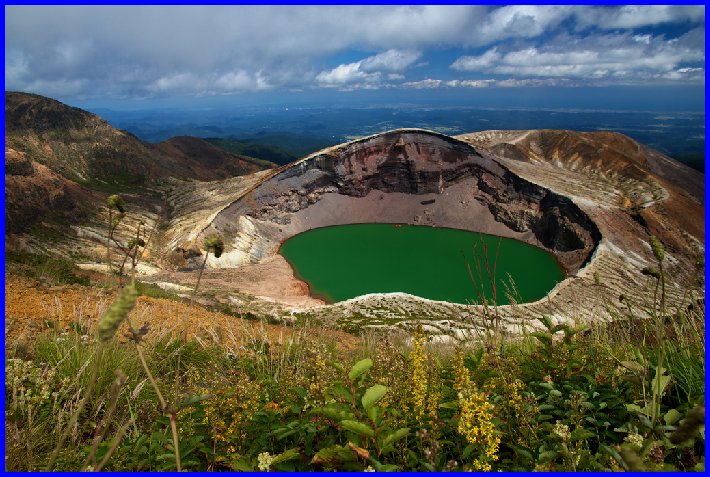
Mount Zao is a complex volcano on the border between Yamagata Prefecture and Miyagi Prefecture in Japan. It consists of a cluster of stratovolcanoes and is the most active volcano in northern Honsh?. The central volcano of the group includes several lava domes and a tuff cone, Goshiki-dake, which contains a crater lake named Okama. Also known as the ‘Five Color Pond’ because it changes color depending on the weather, it lies in a crater formed by a volcanic eruption in the 1720s. The lake is 1,200 ft in diameter and 200 ft deep, and is one of the main tourist attractions in the area.
7. Crater Lake, Mount Katmai – Alaska, USA
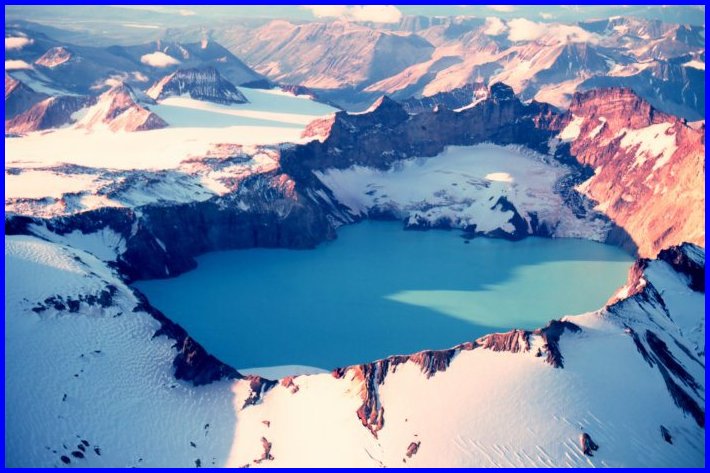
Mount Katmai is a large stratovolcano (composite volcano) on the Alaska Peninsula in southern Alaska, located within Katmai National Park and Preserve. It is about 6.3 miles in diameter with a central lake-filled caldera about 3 by 2 miles in area, formed during the Novarupta eruption of 1912. The caldera rim reaches a maximum elevation of 6,716 feet. In 1975 the surface of the crater lake was at an elevation of about 4,220 feet, and the estimated elevation of the caldera floor is about 3,400 ft. The mountain is located in Kodiak Island Borough, very close to its border with Lake and Peninsula Borough.
8. Vulcan Point within Crater Lake, Taal Volcano – Luzon, Philippines

Taal Volcano is a complex volcano located on the island of Luzon in the Philippines. Historical eruptions are concentrated on Volcano Island, an island near the middle of Lake Taal. The lake partially fills Taal Caldera, which was formed by powerful prehistoric eruptions between 140,000 to 5,380 BP. Viewed from Tagaytay Ridge, Taal Volcano and Lake presents one of the most picturesque and attractive views in the Philippines. It is located about 31 miles south of the capital of the country, the city of Manila.
9. Deriba Crater Lake, Jebel Marra – Darfur, Sudan
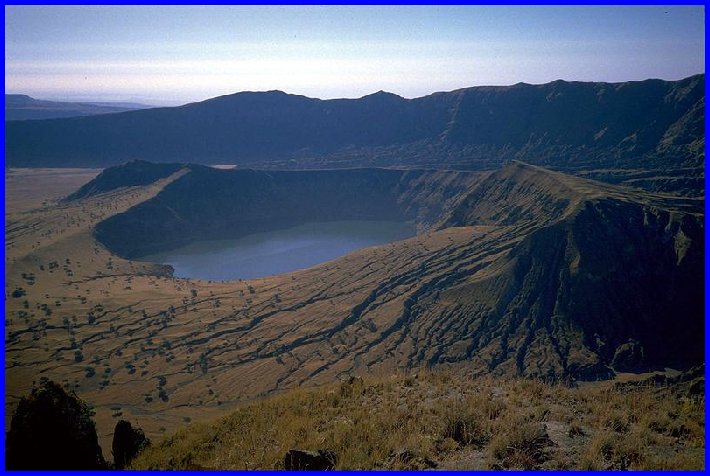
Deriba Crater is at the highest point of Jebel Marra at an elevation of 9,980 ft, in Darfur in the western part of Sudan. The caldera rim became Sudan’s new highest point, after the independence of South Sudan. It is between 5 km and 8 km in diameter across the outer crater. The inner crater is filled by a crater lake. The 5-kilometer-wide Deriba Caldera was formed by explosive eruption of the Jebel Marra Volcano approximately 3,500 years ago. The volcano is considered dormant, rather than extinct, as hot springs and fumaroles (gas and steam vents) are still present.
10. Crater Lake, Mount Ruapehu – New Zealand

Mount Ruapehu, or just Ruapehu, is an active stratovolcano at the southern end of the Taupo Volcanic Zone in New Zealand. It is 23 kilometres northeast of Ohakune and 40 kilometres southwest of the southern shore of Lake Taupo, within Tongariro National Park. The North Island’s major skifields and only glaciers are on its slopes.
11.Yak Loum Crater Lake – Ratanakiri, Cambodia

Yak Loum is a lake and a popular tourist destination in the Ratanakiri province of northeastern Cambodia. Located approximately 3 miles (5 km) from the provincial capital, Banlung, the beautiful lake occupies a 4,000-year-old volcanic crater. Due to the lake’s tremendous depth (157 ft or 48 m), its water is exceptionally clean and clear. The lake is almost perfectly round and measures 0.45 miles (0.72 km) in diameter. Large trees and rich, lush rain forest, the home of many exotic birds and parrots, surround the lake.
12. Kerid Crater Lake, Iceland

Kerid is a volcanic crater lake located in the Grímsnes area in south Iceland, on the popular tourist route known as the Golden Circle. It is one of several crater lakes in the area, known as Iceland’s Western Volcanic Zone, which includes the Reykjanes peninsula and the Langjökull Glacier, created as the land moved over a localized hotspot, but it is the one that has the most visually recognizable caldera still intact.
13. Crater Lake, Licancabur – Chile
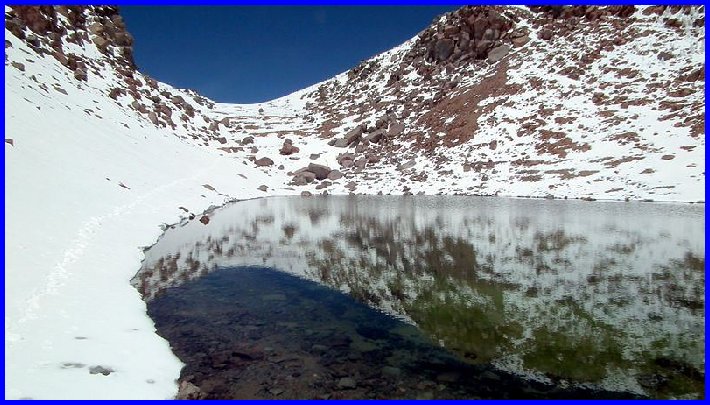
Licancabur is a highly symmetrical stratovolcano on the southernmost part of the border between Chile and Bolivia. It is located just southwest of Laguna Verde in Bolivia. The volcano dominates the landscape of the Salar de Atacama area. The lower two thirds of the northeastern slope of the volcano belong to Bolivia, 5,400 m (17,717 ft) from the foot at 4,360 m (14,304 ft), while the rest and biggest part, including the higher third of the northeastern slope, the crater and summit, belong to Chile.
14. Viti Geothermal Crater Lake, Askja – Iceland

Askja is a stratovolcano situated in a remote part of the central highlands of Iceland. The name Askja refers to a complex of nested calderas within the surrounding Dyngjufjoll mountains, which rise to 1,510 m (4,954 ft), askja meaning box or caldera in Icelandic. The region is only accessible for a few months of the year. Being situated in the rain-shadow to the NE of the Vatnajökull icecap, the area receives only about 450 mm of rainfall annually. The area was used during training for the Apollo program to prepare astronauts for the lunar missions, their main objective in Askja was to study geology.
15. Heaven Lake, Baekdu Mountain – China, North Korea
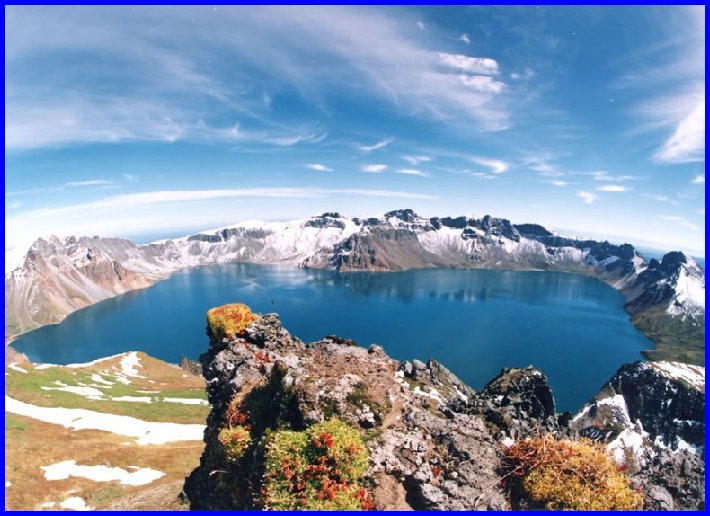
Heaven Lake is a crater lake on the border between China and North Korea. It lies within a caldera atop the volcanic Baekdu Mountain, a part of the Baekdudaegan mountain range and the Changbai mountain range. It is located partly in Ryanggang Province, North Korea, at 42.006°N 128.057°E, and partly in Jilin Province, northeastern China.